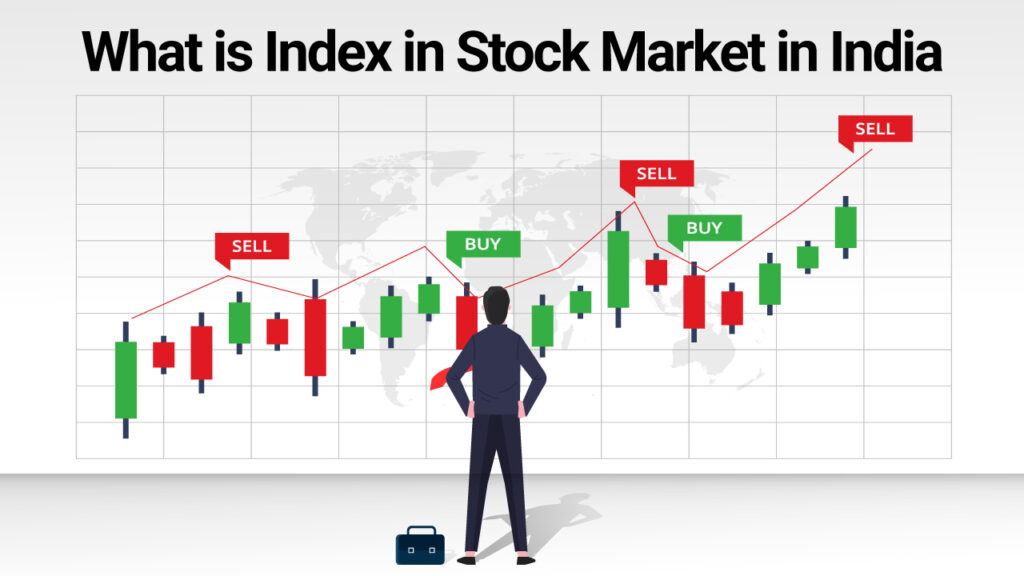Do you also scratch your head when you hear terms like Nifty or Sensex? Don’t worry, you are not alone.
These stock market indices are everywhere in finance reels or headlines — but what is index in stock market? Think of a stock market index as a barometer that reflects the performance of a group of stocks. Knowing this helps investors understand market trends and make better investment decisions.
This blog will simplify it all, from covering the types of index in stock market, how they are formed and why they’re important for tracking market performance.
What is Index in Stock Market
A stock market index is basically a statistical measure that represents the performance of a specific group of stocks. They provide information on whether that specific group of stock is going up, down, or staying steady. These indices represent a specific group of companies and are selected based on a few factors like their size (market capitalization), trading volume, the sector they belong to—such as banking, IT, energy and so on or how often their shares are traded. Investors use such indices to understand how the market is performing and to see if their own investments are doing better or worse than the average.
For example, the Nifty 50 index includes 50 of the largest and most actively traded companies listed on the National Stock Exchange (NSE) whereas the Sensex 30 covers 30 top companies that are listed on the Bombay Stock Exchange (BSE).
Importance of a Stock Market Index
Stock market indices are much more than just the numbers flashing on your screen.They play an important role in how the entire stock market functions.
1. Benchmarking the Performance
You invested in a few stocks. Then how will you know if your investments are doing well or are they underperforming? Here indices come into play. Investors use them as a benchmark to measure their own portfolio’s performance.
For example, if the Nifty 50 rose by 10% in a year and your portfolio gave 12%, then you’d done better than the market.
2. Reading Market Mood
Indices are like a market mood tracker.. When the Sensex or Nifty is rising, it means overall investor sentiment is positive. If they’re falling, it may signal worry or fear or confusion among investors. So indices help understand what the broader market is feeling right now.
3. Helping in Investment Choices
There are sector specific stock market indices too like Nifty Bank, Nifty IT, etc. If a particular sector index is doing well consistently, it may guide other investors to explore opportunities in that particular sector. So indices help an investor in deciding where to invest.
Used to Create Investment Products
Many mutual funds and ETFs (Exchange-Traded Funds) are designed to mirror the performance of an index. For example, a Nifty 50 Index Fund will invest in the same 50 companies that make up the index. This makes it easy for investors to get broad exposure to the market without selecting individual stocks.
Types of Stock Market Indices
The Indian stock market comprises various indices each serving a distinct purpose. Let’s take a look:
1. Benchmark Indices
- Nifty 50: Represents 50 large-cap stocks listed on the National Stock Exchange (NSE). These companies are from various sectors like FMCG, banking, IT, and energy. This index gives a broad picture of the Indian economy. When someone says “Nifty is up today,” it means that the average value of these top 50 companies has increased, reflecting positive market sentiment.
- BSE Sensex: The Sensex (short for Sensitive Index) tracks 30 companies that are the most established and financially sound,listed on the Bombay Stock Exchange (BSE). These 30 companies are considered as leaders in their respective industries and their selection is based on their market capitalization and liquidity. Like the Nifty, the Sensex acts as a pulse of the Indian stock market so when the Sensex rises or falls, it indicates the general direction of the market.
These 2 are the most popular indices in the Indian stock market. These indices provide a snapshot of the overall market performance.
2. Sectoral Indices
These indices focus on specific sectors:
- Nifty Bank: This index includes India’s top banking sector stocks which are listed on the NSE, such as HDFC Bank, ICICI Bank and SBI. This index reflects the overall performance of India’s banking industry. So, if Nifty Bank is rising, it usually means banking stocks in India are doing well.
- Nifty IT: This index tracks India’s biggest and most influential information technology companies like Infosys, TCS and Wipro. It helps investors in understanding how the tech sector is performing, especially during times of global digital demand.
- Nifty Pharma: This index includes prominent pharmaceutical companies such as Sun Pharma, Dr. Reddy’s and Cipla. It shows how the pharma industry in India is moving. This index becomes most relevant during health-related global events or policy changes.
Such sectoral indices help investors in assessing the performance of particular industries.
3. Market Capitalization-Based Indices
These indices categorize companies based on their market capitalization:
- Nifty Midcap 100: This index tracks the performance of 100 mid-sized companies that are listed on the NSE. These firms are usually larger than small-caps but smaller than large-caps. Examples include companies like Max Healthcare or Bharat Forge. Investors often look at this index to find companies with high growth potential and slightly lower risk than small-caps.
- Nifty Smallcap 100: This index represents 100 smaller companies that have lower market capitalization. These companies are often emerging businesses or niche players. While small-caps can offer high returns, they also carry higher risk due to lower liquidity and high price volatility.
Market capitalization based indices helps investors in understanding the performance of different segments of the market.
Thematic Indices
These indices focus on specific investment themes or market trends:
- Nifty Next 50: This index includes those 50 companies that are ranked just below the Nifty 50 in terms of market capitalization. These companies are often seen as the one “next in line” that will potentially enter the Nifty 50, making it a popular choice among investors looking for future large-cap leaders. Examples include Adani Green, Varun Beverages, and others.
- Nifty India Consumption: Tracks companies involved in consumption-driven sectors like retail, FMCG, etc. This index tracks companies that are involved in India’s consumption-driven economy, such as retail, FMCG, food, beverages and lifestyle. It reflects the spending patterns of India’s growing middle class. Firms such as Hindustan Unilever, Titan, and Jubilant FoodWorks are part of this index.
Thematic indices help investors in focusing on specific market trends or sectors of their interest.
- Strategic Indices – These indices are designed keeping specific strategic goals in mind:
- Nifty 50 Equal Weight – In this index, each of the 50 stocks included in the Nifty 50 has an equal weightage, meaning every stock contributes the same amount to the overall performance of the index. Unlike traditional indices, where the weight of a particular stock is based on its market capitalization (larger companies have more influence), the equal-weight index avoids this by giving each stock the same importance.
- Nifty 50 Low Volatility – This index includes those stocks from the Nifty 50 that show lower price volatility, meaning their stock prices tend to fluctuate less as compared to the broader market. The key is to select those stocks that have historically shown stable performance, making them less prone to large price changes.
Strategic indices help investors in diversifying or minimising risk by using alternative weightings or volatility-based approaches.
There are several stock market indices beyond these five, that cater to various investment strategies, sectors, market capitalizations and specific themes, offering investors a broader range of options for targeted exposure and diversified investments.
Formation of a Stock Market Index
The formation of a stock market index involves a few simple steps.
Selection of the Stocks
For forming an index a set of stocks is chosen based on a few criteria. These criteria could include the size of the company (market capitalization), the industry it belongs to or its historical performance.
For example, in the Nifty 50, the 50 of the largest and most actively traded companies on the NSE are included in this index.
Assigning Weights to the Stocks
Each stock in the index is given a certain weight depending on factors like its market capitalization (the total value of the share of the company). Larger companies generally have a higher weight in the index.
For example, if Reliance Industries has a larger market cap compared to Tata Motors, it will have a higher weight in the index.
Example:
- Reliance Industries: Market cap = ₹10 lakh crore, weight = 10%
- Tata Motors: Market cap = ₹2 lakh crore, weight = 2%
Calculating the Index Value
The value of an index is calculated by taking the weighted average of the prices or market caps of the stocks in the index. A common method is to use a “base value” for the index and adjust it regularly to see the changes in the prices of the stocks.
For Example:
- Suppose the index is calculated based on the prices of the stocks. If Reliance Industries stock price increases by ₹100, then index’s value will go up more than that of Tata Motors if their stock price increases by ₹100, because Reliance has a higher weight.
Tracking Performance
The final index value reflects how well the group of stocks is performing as a whole. It provides investors with an easy way to see what’s going on in the market. If the index value goes up, that means the stocks in the index are performing well and if it goes down, they’re underperforming.
For example, if the BSE Sensex (which includes 30 large companies) goes up by 500 points in a day, it shows that, on average, the stocks in the Sensex are doing better that day.
Summary
Understanding what is index in stock market in India is a must for anyone starting their investment journey or often getting confused with this term.
Indices are like the report card of the stock market that shows how a selected group of stocks is performing and gives you a clear picture of market trends. Indices also play a crucial role in stock selection.
By tracking the performance of different indices, an investor can identify which sector or stock is showing growth potential.
For instance, if a sector index is doing well, the stocks within that sector might perform better too. On the other hand, poor performance in an index can act as a warning. Whether it’s the Nifty 50, Sensex or sector-based indices, they help investors track performance, make smart decisions and understand where the market is headed.
Pros and Cons
Mutual Funds
Pros:
- Managed by a professional fund manager
- A diversified portfolio thus reduces risk
- Suitable for beginners
- Systematic Investment Plans (SIPs) allow disciplined investing
Cons:
- Management fees and expenses to be paid to the fund manager.
- Less control over individual investments.
- Returns may be lower compared to stocks
Stocks
Pros:
- Potential for high returns..
- Full control over investment choices
- Dividends provide regular income.
Cons:
- High risk due to market volatility.
- Requires in-depth market knowledge and research.
- Emotional decision-making can lead to losses.
How to choose the Right Mutual Fund or Stock?
Mutual Funds:
- Start with your goal
Wish to buy a house in 5 years? Planning for your retirement? Want to send your child abroad for education? Choose a fund based on your timeline — short, medium, or long-term. - Know your risk appetite
If you’re cautious and not a risk taker then debt or hybrid funds are safer. If you can take more risk for higher returns than equity mutual funds may suit you. - Pick the right type of fund
- Equity funds if you want to create long-term wealth
- Debt funds for stability and lower risk
- Hybrid funds for a mix of both
- Equity funds if you want to create long-term wealth
- Check fund’s performance
Look for consistency in the fund. Don’t go for flashy one-year returns. See how the fund performed in up and down markets. - Compare fees (expense ratio)
Lower expense ratios can mean more returns in your pocket over time. - Research the fund manager’s track record
A good fund manager = better fund handling during market ups and downs.
Stocks:
- Do fundamental analysis
Study the company’s profits, growth, debt and market position.
Example: If you’re eyeing Tata Motors, check their revenue, EV plans, and check their competitors. - Understand broader market trends
Are interest rates rising? Is the economy growing? Can the global crisis affect the market? These factors can affect stock performance so understand them. - Diversification
Don’t put all your money into one stock or sector. Go for multiple sectors like banking, tech, auto, pharma, etc., to manage risk. - Stay updated
Follow the company announcements, earnings reports and news that might impact their business and your money - Learn before you reap
If you’re a beginner, consider taking structured lessons like VIDFIN’s Stock Market Essentials course. It helps you build a strong base in picking quality stocks and avoiding common mistakes.
Mutual Funds vs Stocks: Which Is Better for Investment?
If you are also confused between these two investment options then it’s important to understand their differences and align them as per your financial goals.
Mutual Funds
- Diversification:
- Mutual funds offer instant diversification by pooling money from many investors.
- You have exposure to a mix of stocks, bonds or other securities without picking them individually.
- Professional Management:
- A fund manager makes investment decisions on your behalf.
- Their goal is to minimize risk while meeting the fund’s objective.
- A fund manager makes investment decisions on your behalf.
- Risk and Return:
- These usually involve moderate risk, lower than direct stock investments.
- Returns vary based on the fund’s performance and market conditions.
- These usually involve moderate risk, lower than direct stock investments.
- Cost and Tax Benefits:
- Lower Costs: Most mutual funds charge relatively low fees.
- Tax Benefits: Certain funds like ELSS (Equity-Linked Saving Scheme) are eligible for deductions under Section 80C.
- Lower Costs: Most mutual funds charge relatively low fees.
Stocks
- Ownership:
- Buying stocks means owning a part of a company, becoming an owner.
- You become a shareholder with voting rights and a share in the profits of the company.
- Buying stocks means owning a part of a company, becoming an owner.
- High Risk, High Return:
- Stocks can be volatile and are generally considered high-risk investments.
- Offer the chance for higher returns than mutual funds.
- Stocks can be volatile and are generally considered high-risk investments.
- Direct Participation:
- You’re directly involved in the stock market.
- Returns come from both dividends and stock price appreciation.
- You’re directly involved in the stock market.
- Diversification Challenge:
- For diversification in stocks, you need to invest in multiple companies (usually 15–20), which takes time, research, and effort.
Risk, Returns & Market Exposure
When comparing mutual funds and stocks, it is important to understand how each performs in real market conditions. Let’s break this down with actual numbers and scenarios.
- Mutual Funds
Mutual funds mostly aim for moderate and consistent returns by investing in a diversified mix of assets.
- Example: If you had invested ₹5 lakhs in the Nippon India Growth Fund 5 years ago, with a 5-year return of approximately 33.49% annually, your investment would have grown to around ₹21.5 lakhs today.
If you had done a SIP of ₹10,000/month in Quant Flexi Cap Fund for the last 5 years:
- Total invested: ₹6 lakhs
- Final value: ~₹10.2 lakhs+
- Average SIP returns: 17.5–18% CAGR
- Stocks
Stock investing offers high returns but the potential for higher return but also comes with higher volatility and risk.
- Example:
If you had bought Tata Motors shares in April 2020 at~ ₹72/share and held them till April 2024 ~(₹645), your ₹50,000 investment would now be worth ~₹4.47. - However, if you had invested in Yes Bank in 2018 at ~ ₹320/share, and held till now (~₹17), your ₹50,000 investment would be worth barely ~₹2,500.
Real Life Insight:
Most salaried individuals will prefer mutual funds because of stability and its simplicity, while seasoned investors opt for stocks to chase higher returns — understanding that the potential for loss is also greater.
Summing Up
Mutual funds vs stocks can be confusing, and choosing one isn’t just about returns. It’s more about what suits your financial goals, how much risk you’re comfortable with and how much time you can dedicate to managing your money.
- If you’re just starting out (beginner) or want a hands-off approach, mutual funds are a smart choice. They offer diversification and are managed by professionals, making them ideal for long-term goals like retirement or buying a house or children’s education.
- If you’re open to taking more risk for the chance of higher returns, and you’re confident in understanding the markets, then investing in stocks can offer that potential along with more control.
Remember, it is not always about choosing one over the other. You can build a balanced portfolio with both mutual funds and stocks that helps manage risk while also chasing growth. So choose wisely.



